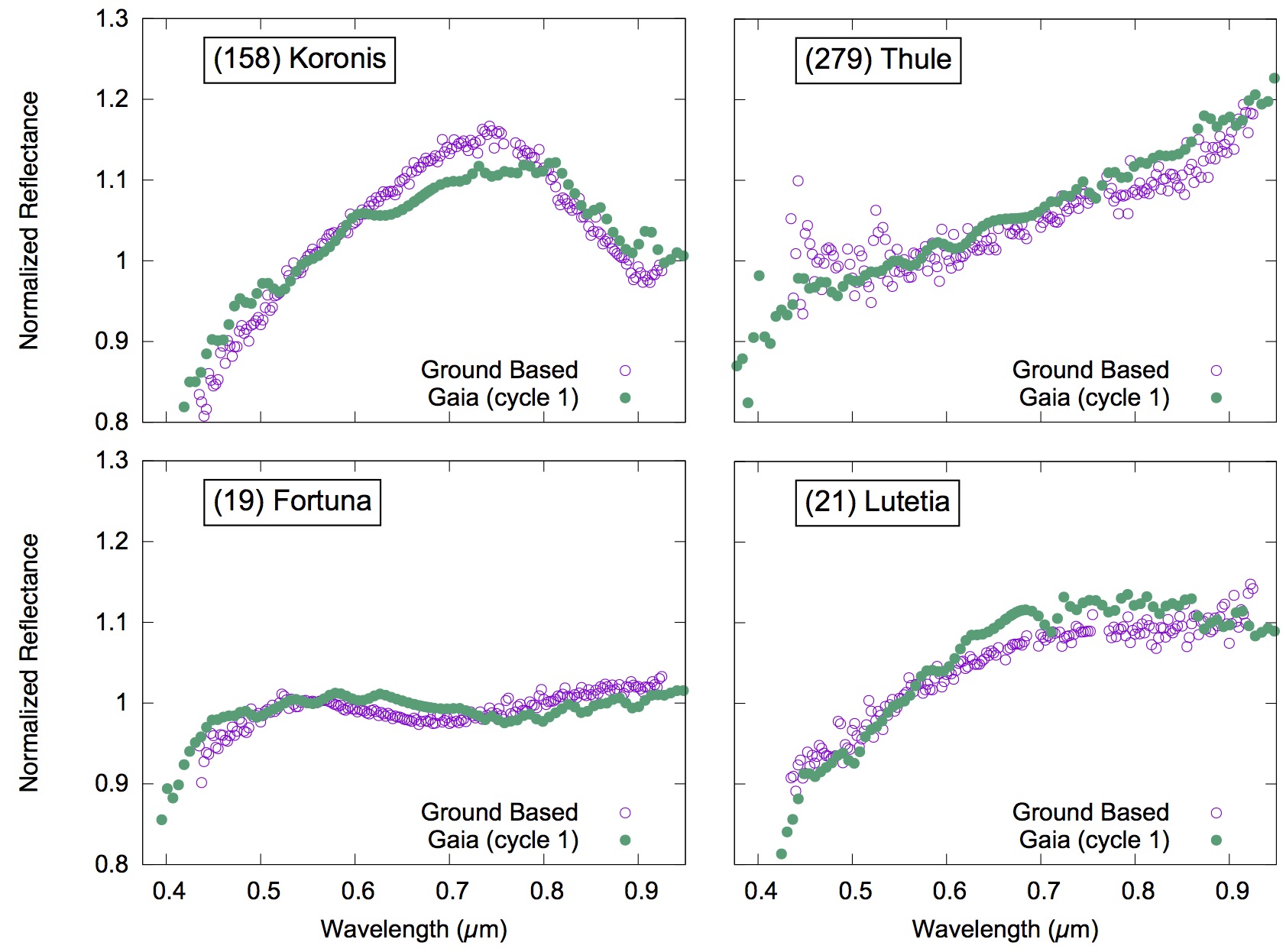IoW_20170424 - Gaia
Image of the Week |
Gaia reveals the composition of Asteroids |
 |
|
Figure 1: Gaia reflectance spectra (green circles) of four asteroids with well known ground-based spectra (violet circles). The Gaia BP and RP data, which are calibrated independently, are merged in one single reflectance. The ground based data were obtained from the (Small Asteroid Spectroscopic Survey) SMASS of the MIT in the USA. Error bars due to the photometric uncertainties are of the order of the size of the plot symbols (also for the ground-based data). However, systematic uncertainties are certainly bigger due to the still preliminary calibration of the Gaia BP and RP data used here (see text). (Image credit: ESA/Gaia/DPAC/CU4+CU5/Marco Delbo) |
|
While Gaia is pinpointing the positions of more than one billion stars with unprecedented accuracy, it also catches the light of asteroids along the way. The visible-light spectra of these asteroids is measured using Gaia's Blue and Red photometers (BP and RP for short). Asteroid spectra are very important for planetary scientists: spectra carry information about the composition of the body, allowing to distinguish, for instance, rocky from carbonaceous and/or water-rich asteroids. As asteroids are the leftovers of the bricks that built the planets 4.5 Gyr ago, their composition gives to scientists clues about the planetary formation processes and the evolution of the Solar System. Even considering the preliminary nature of these data, the agreement with the known spectra shows the potential of Gaia in this kind of analysis. The measurement of asteroid spectra requires a delicate approach and coordinated team-work: each single Gaia observation is calibrated by the Photometric processing unit (CU5) in Cambridge (UK) taking into account the responses of the BP and RP instruments. The contribution of the solar spectrum is then removed from the several observations that Gaia obtains for each asteroid, in order to derive the reflectance of its surface. This is the fraction of incident solar light that is reflected by the surface. This procedure is part of a fully automated processing of spectra that runs at the CNES Data Processing Centre (also called the DPCC in Toulouse, France) and it is being optimised at the Observatoire de la Côte d'Azur (Nice, France) as part of the “Object processing” unit (CU4). By comparing the reflectance spectrum as a function of wavelength with those of meteorites and different minerals, planetary scientists derive the composition of asteroids. In the accompanying image we show spectra that Gaia obtained for asteroids whose diverse reflectance spectra were already known from previous ground-based telescopic observations. The spectrum of asteroid (158) Koronis is similar to those of ordinary chondrite meteorites; that of (19) Fortuna is compatible with CM carbonaceous chondrite meteorites; (21) Lutetia with enstatite chondrite meteorites; and (279) Thule with cometary nuclei (ESA’s Rosetta mission showed that cometary nucleus has an organic-rich and dehydrated surface). The scientists of DPAC (the Data Processing and Analysis Consortium) use asteroids with well measured spectra to validate the quality of Gaia measurements. The spectra presented in the figure are based on an early calibration of the Gaia instruments. These "cycle 1” data were not made public and are not intended for scientific use, as the full calibration was not yet complete at the cycle 1 stage. This might explain some discrepancies between the Gaia and the ground based spectra, also shown in this figure. Even considering the preliminary nature of this data, the agreement with the known spectra is remarkable and shows the high potential of Gaia in this kind of analysis. Thanks to efforts of Gaia scientists, the instrument calibrations are improving and likewise the reliability of asteroid spectra. Eventually, Gaia will provide the largest survey of asteroid spectra ever made. This will allow planetary scientists to build a map of the composition of the Main asteroid Belt and of other populations of asteroids, such as that of the near-Earth and the potentially-hazardous objects. Several DPAC Coordination Units were involved in the preparation of this story. Laurent Galluccio, Marco Delbo and Francois Mignard from CU4 and Francesca De Angeli from CU5 helped preparing this story. A special acknowledgement and thank you also to Paolo Tanga, Alberto Cellino and Anthony Brown for their supervision. |
|
Credits: ESA/Gaia/DPAC/Galluccio/DeAngeli/Delbo/Mignard [Published: 24/04/2017] |
- Removed a total of (5) style text-align:center;
- Removed a total of (5) style text-align:justify;
- Removed a total of (1) border attribute.
- Removed a total of (1) cellpadding attribute.
- Removed a total of (1) cellspacing attribute.
Image of the Week Archive
- Removed a total of (1) border attribute.
- Removed a total of (1) cellpadding attribute.
- Removed a total of (1) cellspacing attribute.








































 Sign in
Sign in
 Science & Technology
Science & Technology